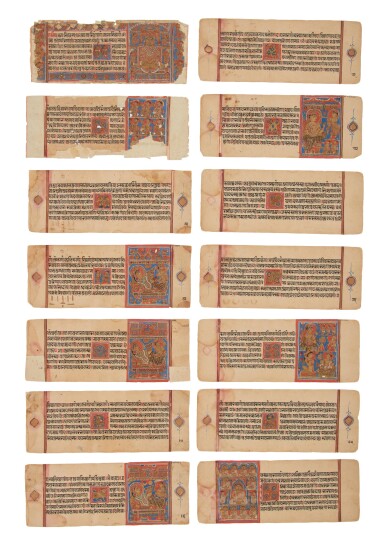
Property of a Singapore Collection
A Group of Double-sided Eighty-eight Illustrations to a Kalpasutra Manuscript, India, probably Gujarat, circa 16th Century
Auction Closed
September 20, 05:33 PM GMT
Estimate
40,000 - 60,000 USD
Lot Details
Description
Property of a Singapore Collection
A Group of Double-sided Eighty-eight Illustrations to a Kalpasutra Manuscript
India, probably Gujarat, circa 16th Century
Pigments and ink on paper heightened with gold
4½ by 11¾ in. (11.4 by 29.8 cm), (88), unframed
Spink & Son, before 1985.
The set of eighty-eight double-sided illustrations to the Kalpasutra depicting legends from the lives of the jinas, with particular focus on the story of Mahavira.
The Kalpasutra (Book of Ritual), the main canonical text in Jainism, was believed to have been composed in the fourth century BCE with numerous extrapolations added over the following millennia. It relates accounts of the lives of the 24 jinas (Conquerors) of the Jain faith, including a detailed biography of Mahavira, the last jina. The text also codifies guidelines for ascetics to follow during the monsoon season, when they rest from their travels. These teachings are read and observed by Svetambara Jains during the annual eight-day festival of Paryushan.
Most of the leaves in the present manuscript depict scenes from the jina Mahavira’s life. According to legend, for his final rebirth, Mahavira was to be born to Devananda, a Brahmin woman. However Indra was determined that jinas must be born from the Kshatriya or warrior class alone. Therefore he commanded his deer-headed general, Harinegamesi, to switch the embryos between Devananda and Queen Trishala, the pregnant wife of King Siddhartha. Queen Trishala then had fourteen auspicious dreams signifying that she would give birth to a jina. She became mother to Mahavira who distinguished himself as an ideal son since the very beginning of his gestation in her womb. At the age of 33, upon the demise of his parents, Mahavira renounced his worldly possessions and embraced a life of asceticism. The present group of illustrations depict these episodes as well as stories of the two other highly venerated jinas - Parshvanatha and Rishabhanatha.
During the twelfth century, King Kumarapala the Solanki ruler of Gujarat, who was an ardent Jain, commissioned and distributed hundreds of copies of the Kalpasutra to propagate the faith throughout his realm. The early texts were illustrated and written on palm-leaf which was replaced with paper in the fifteenth Century. The elongated proportions of the palm leaves were however maintained to create manuscripts in horizontal format, such as the present lot. Scenes picturing highlights from each story are placed within compartments, some further sub-divided into registers, with lines of text on the rest of the page and numbered margins. The very first leaf depicting the crowned, enthroned and garlanded Mahavira has a lively decoration of musicians and dancers on both margins. All the figures are represented with clarity and economy of line and sumptuously illustrated with red and blue pigments embellished with gold. The faces are executed in characteristic three-quarter profile and bear an extreme, exaggerated ‘fish-eye.’
With the passage of time innumerable such manuscripts illustrating the Kalpasutra and a closely related text – the Kalakacaryakatha – were commissioned by the increasingly wealthy Jain mercantile community in Western India, to accumulate merit for themselves and their forbears. These texts were housed in temple libraries (bhandars) and over time, the act of worshipping such sacred books (jnanapuja) became part of Jain ritual practice itself.
For more discussion on Jain art and on manuscript paintings in particular, see P. Granoff, Victorious Ones: Jain Images of Perfection, Ahmedabad, 2009, J.V. Alphen, Steps to Liberation: 2500 Years of Jain Art and Religion, Antwerp, 2000, and P. Pal, The Peaceful Liberators: Jain Art from India, New York, 1994).
You May Also Like










